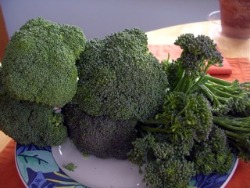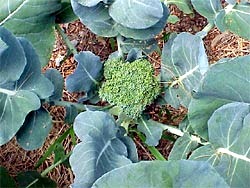
The common large headed broccoli (left) is the modern version of the old fashioned, smaller headed sprouting broccoli (right).

Broccoli heads size up quickly in spring with cool weather, moisture and fertility.
There are a few vegetables that are quintessentially Italian and broccoli is certainly one of them. This "wild cabbage" is native to the
Mediterranean and was first cultivated thousands of years ago by
Romans. The Italian word "brocco" means branch or arm. Early varieties
were first grown for their leaves and shoots. It was only later through
plant selection and breeding that broccoli flower heads became an
important edible part of the plant.
This "Italian asparagus" was introduced to other parts of Europe and America in the 1700s and is sometimes confused with other similar
vegetables. In fact, in England the term broccoli still refers to
broccoli's cousin, cauliflower. Although grown for a few hundred years
by Italian immigrants in America, it only became widely grown in the
1920s. However, broccoli has gone through an explosion in popularity in
the last 20 years, especially since the discovery that it contains good
amounts of vitamins C and K and anti-oxidants such as sulforaphane that
help prevent cancer.
Broccoli has a milder flavor than cabbage, and different variations of broccoli are now available for growing and eating. The heading
broccoli that most people know features one large flower head eaten
before the small flowers open. Sprouting broccoli tends to have a
smaller main head, but many large side shoots. Broccoli raab and
broccolini are related to broccoli but grown for their edible stems and
shoots as well as small heads. Romanesco broccoli is actually a
cauliflower/broccoli cross and has one large, light colored head with
unique spiral shapes.
Whatever variety you choose, broccoli tastes great steamed, sauteed, cooked in soups and casseroles, or eaten raw. It's nutritious, delicious, and easy to grow.
Planning
Broccoli, like all cabbage family crops, grows, matures, and tastes best during cool temperatures. It's traditionally grown as a spring or
fall crop. In mild winter areas, there are overwintering varieties that
are planted in fall for a late winter/early spring harvest.
There are an ever expanding number of broccoli varieties available for home gardeners to grow. They all grow best with full sun, fertile
soil, plenty of water, and cool air. Most large headed varieties mature
in 60 to 90 days from transplanting. Sprouting and small, multi-head
types can mature in as little as 45 days from transplanting. Most
plants grow 1- to 3-feet tall and wide. Here are some of best ones to
try. The days to maturity are from transplanting. Add 2 to 3 weeks if
grown from seed directly planted in the garden.
'Arcadia Hybrid' (63 days) – This rugged variety grows well in all seasons, producing firm, 5-inch wide, dark green heads with a frosted purple appearance. The plants are very disease resistant.
'Belstar Hybrid' (66 days) – This broccoli is widely adapted, growing well across the country in spring and fall and producing well
in winter in mild areas. It produces medium-sized, domed heads on
plants that can tolerate stress and still produce.
'Calabrese' (80 days) – This old heirloom features 2- to 3-foot tall plants with 5 inch diameter, blue-green heads. This sprouting variety produces many large, side shoots after the main head is cut.
'De Cicco' (48 days) – A sprouting type broccoli that produces small, 3- to 4-inch diameter heads and lots of side shoots and heads once the main head is cut.
'Early Fall Rapini' (45 days) – This broccoli raab variety grows 1- to 2-feet tall, producing tasty small heads, tender stems, and edible
leaves. While this variety is best for fall production, it varies
little from other broccoli raab varieties for spring production.
'Packman Hybrid' (55 days) – A popular early maturing variety that produces large, 9-inch diameter, sage green heads. The plants are uniform and very productive.
'Purple Peacock Sprouting' (120 days) – A unique sprouting variety with small, purple heads that turn green when cooked. Well adapted to cold weather and often grown for winter production in mid climates.
'Veronica Hybrid' (85 days) – This Romanesco variety features 7-inch diameter, chartreuse heads with a unique spiral shape. Like a cauliflower, is usually produces just one main head.
'Windsor Hybrid' (56 days) – This early maturing variety has 6- to 7-inch diameter heads that are cold, heat, and disease tolerant.
Planting

Broccoli can be grown as a fall crop, transplanting seedlings into the garden in late summer.

Check broccoli plants regularly for signs of cabbage worms on leaves and heads.
Broccoli needs fertile soil to grow its best. Amend the soil with a 2- to 3-inch thick layer of compost before planting, and work it into
the soil. While broccoli can be grown from seed to mature in many
areas, it's best to start plants indoors 4 weeks before your last frost
date and transplant young seedlings out into the garden for earlier
maturity. You can also plant in late summer or fall for a fall or
winter harvest. In warm winter areas, fall planted sprouting varieties
will overwinter and mature in early spring.
Plant seeds 1/2-inch deep, 18 inches apart, in rows 3 feet apart. Transplant seedlings 10- to 18-inches apart, depending on the variety.
Care
Broccoli transplants are slow growing at first, so keep the beds well weeded and watered. Once they start putting on new growth, mulch
the beds with a 2- to 3-inch thick layer of hay, untreated grass
clippings, chopped leaves, or pine straw. This organic mulch keeps the
soil cool, evenly moist, and prevents weeds from growing.
Side dress young broccoli transplants every three weeks with a fertilizer high in nitrogen. Purple leaves are a sign of phosphorous
deficiency. This can occur when cool spring soils keep phosphorous from
being readily available to plants. Don't add more fertilizer unless the
condition persists once the soil warms.
Broccoli plants can button, or form premature, small heads if exposed to 35F to 50F degree temperatures when the seedling stems are
only 1 inch in diameter. Cover young plants with a floating row cover
if cold weather threatens in spring.
While broccoli can be attacked by aphids, flea beetles, and slugs, the biggest threats are cabbageworms and cabbage loopers. Control these
little green worms by spraying Bacillus thuriengensis (Bt) on the
plants as soon as you see small, white adult butterflies fluttering
around plants or young green caterpillars on the leaves. Prevent
rabbits and woodchucks from eating young broccoli plants by erecting
fences. Stop cutworms from felling young transplants by placing cutworm
collars around the seedlings.
Harvest
Harvest broccoli heads when the buds have swelled, but haven't opened yet. If the yellow flowers open, the head will be less
flavorful. Cut the main head 6-inches below the flower head. On most
varieties, smaller side shoots will form along the main stem and
continue forming until frost Cut these as their heads form.
Views: 6
© 2025 Created by Aggie.
Powered by
![]()